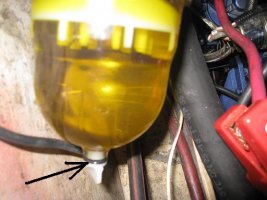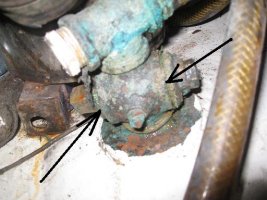Guest viewing is limited
- You have a limited number of page views remaining
- 20 guest views remaining
- Register now to remove this limitation
-
Untitled Document Join us on March 28th, 7pm EDT
for the CBEC Virtual Meeting
EY.o March Zoom Meeting
All EYO members and followers are welcome to join the fun and get to know the people you've met online!
See the link below for login credentials and join us!
(dismiss this notice by hitting 'X', upper right)
You are using an out of date browser. It may not display this or other websites correctly.
You should upgrade or use an alternative browser.
You should upgrade or use an alternative browser.
Where's the mast? Wouldn't it have been easier to step the mast while the boat was out of the water?
All the yards in our area have Travelifts and they all use an aux. winch on the main cross beam to step (or unstep) masts while the boat is afloat. I imagine that the larger and taller the spar is more likely this would be the only safe method of handling the spar.
Loren
sveinutne
Member III
The main reason the mast is not put on now, is because I want to paint it and make it look better. I also need to do some repair and replace some items on the mast. But I am also very angus to test the hydraulic drive, and did not want to wait till next spring for this testing.</SPAN>
sveinutne
Member III
I finely got all the parts and manage to fill the hydraulic tank with oil, about 15 liters. It was interesting to see if the propeller was turning the right way, but to may surprise everything with the hydraulic was working fine and the propeller turned the right way. Now there are still two problems that need to be fixed before I will run the engine for more than 2 minutes. The pack box is getting too hot, and the dripping is at a high rate about 1 drop per second. The second problem is the water cooling. The intake of seawater is going through an old filer system that I did not replace, but when I open the valve today water was not coming to the engine, so at the moment the engine is cooled by a house from land.</SPAN>
sveinutne
Member III
I have done two things wrong with the packing box. Fist I did not get the 3/16 inch Teflon impregnated flax, but had to use the 1/8 inch. Second I did not use Teflon putty. I will try to get Teflon putty to see if that might help, or some other Teflon past.</SPAN>
The water cooling I hope will be fixed by getting a new filter.</SPAN>
If I can find this product I might try that too:</SPAN>
http://www.westmarine.com/webapp/wcs/stores/servlet/ProductDisplay?catalogId</SPAN>
=10001&storeId=11151&partNumber=255358&langId=-1
It works as a lubricant along with the Teflon flax and the Teflon putty
as an essential part of the step by step process to deliver virtually
drip-free operation while keeping the stuffing box temperatures down.</SPAN></SPAN>
The water cooling I hope will be fixed by getting a new filter.</SPAN>
If I can find this product I might try that too:</SPAN>
http://www.westmarine.com/webapp/wcs/stores/servlet/ProductDisplay?catalogId</SPAN>
=10001&storeId=11151&partNumber=255358&langId=-1
It works as a lubricant along with the Teflon flax and the Teflon putty
as an essential part of the step by step process to deliver virtually
drip-free operation while keeping the stuffing box temperatures down.</SPAN></SPAN>
sveinutne
Member III
Now I got some serious problems. I have some small oil leak, and when I opened the true hull for the cooling of the engine I got some water leak too. This water leak would not be a problem if I could let the bilge pump handles it, but with the oil leak, I had to turn of the bilge pump, so I do not risk oil spill in the marina. So now I have to drive down to the marina and see how much water that needs to be pumped out after two hours of leaking. Then I will make some calculation to find out if I need to run down in the middle of the night, or if it can wait till tomorrow morning for the next run.</SPAN></SPAN>
I want to find out where the oil leak is coming from before I drain the oil, so tomorrow I will try to be an oil leak detective.
</SPAN></SPAN>
I want to find out where the oil leak is coming from before I drain the oil, so tomorrow I will try to be an oil leak detective.
</SPAN></SPAN>
sveinutne
Member III
It was a pleasant surprise to see the water level in the bilge was not so high. I pumped out less than 5 liters of water from the last 10 hours. But I think I got two sorts of oil in the water. I got some hydraulic oil, and some black oil. The black oil is still a puzzle to me, but I wonder if that could be very old oil from Florida, from the time it was laying there with water and maybe some black oil. The hydraulic oil is like vegetable oil and has a transparent or greenish color. So maybe this leakage will help me remove the last fragments of old oil.</SPAN>
Last night I was wondering if I should pull the boat out of the water, but now with the reduced leakage I get more time to think. The water leakage is from the fittings on the side of the seacock. This is old bronze 1 and ¼ size seacock’s. I have three of them left. One is for the engine cooling and the other two is for the toilet. The next time I take the boat out of the water I will at least change all the fittings, or maybe the whole thing. </SPAN>
Now I wonder how to block the water from entering while I change the fittings. I plastic cover on the outside might help or a plug put in the hole from outside? But it is Sunday today and all shops are closed, so I cannot even ask if they got the parts I might need.</SPAN></SPAN>
Last night I was wondering if I should pull the boat out of the water, but now with the reduced leakage I get more time to think. The water leakage is from the fittings on the side of the seacock. This is old bronze 1 and ¼ size seacock’s. I have three of them left. One is for the engine cooling and the other two is for the toilet. The next time I take the boat out of the water I will at least change all the fittings, or maybe the whole thing. </SPAN>
Now I wonder how to block the water from entering while I change the fittings. I plastic cover on the outside might help or a plug put in the hole from outside? But it is Sunday today and all shops are closed, so I cannot even ask if they got the parts I might need.</SPAN></SPAN>
sveinutne
Member III
The water leak is now even less, so I think there is no reason for panic. The leak is from the old gaskets that are on each side of the ball valve as you can see from the arrows in the picture. One other problem I got is the new water separator I installed on the diesel line to the engine. The water should be trapped and you can then see the water through the glass, and drain it out through the bottom screw, as you can see in the other picture. The problem is that diesel is dripping out and air is going in from this bottom screw. I tried to tighten the bottom screw but it did not help much, so now I wonder if it should be like this or if there is something wrong with it?</SPAN>
Attachments
I would haul her when you first can and replace the bronze fitting in the hull as well as the valves with modern seacocks. Do the hole thing - through hulls and seacocks and backing plates. I wouldn't attempt to replace just the valves in the water. I've had old through hulls come apart on me e.g. break off at the hull, when working on the valves attached to them. Meanwhile, don't mess with them and stress them. I'm guessing the old packing has swollen with water and is why it is sealing better, but movement could cause them to leak suddenly.
You shouldn't have any leaks from your fuel/water separator. Usually there is a rubber o-ring on the drain plugs on something like this. Do you have one or could you add one? Even a flat nylon washer might help.
You shouldn't have any leaks from your fuel/water separator. Usually there is a rubber o-ring on the drain plugs on something like this. Do you have one or could you add one? Even a flat nylon washer might help.
sveinutne
Member III
Hi David,</SPAN></SPAN>
There is an o-ring on the drain plug. I looked at the drain plug, and it has a cut going all the way through all the threads, and it looks like intentionally made from the factory, but I will try to clean the o-ring and see if that might help.</SPAN></SPAN>
About the bronze fittings, I am blaming my self for not replacing all of them when I had her on dry land. I have broken of one of the old ones, so I know how delicate they can be after 40 years at sea, but I don't want to pull here out if I can find a way to replace the fittings at sea in a gentle way.</SPAN></SPAN>
I was planning to put a rubber plug in the hole from the outside, then take the ball and fittings out gently and put a wooden plug in where the ball was to seal while I find replacement gaskets. It might be a bit risky if I break the valve off in the hull, but I hope the ball can be taken out with a minimum of force. Maybe I should have a diver in the water while I do this, so he can put something that will seal of the hull if needed.</SPAN></SPAN>
There is an o-ring on the drain plug. I looked at the drain plug, and it has a cut going all the way through all the threads, and it looks like intentionally made from the factory, but I will try to clean the o-ring and see if that might help.</SPAN></SPAN>
About the bronze fittings, I am blaming my self for not replacing all of them when I had her on dry land. I have broken of one of the old ones, so I know how delicate they can be after 40 years at sea, but I don't want to pull here out if I can find a way to replace the fittings at sea in a gentle way.</SPAN></SPAN>
I was planning to put a rubber plug in the hole from the outside, then take the ball and fittings out gently and put a wooden plug in where the ball was to seal while I find replacement gaskets. It might be a bit risky if I break the valve off in the hull, but I hope the ball can be taken out with a minimum of force. Maybe I should have a diver in the water while I do this, so he can put something that will seal of the hull if needed.</SPAN></SPAN>
Mort Fligelman
Member III
Seacocks/Valves Through Hull Fittings
Svein:
I would have to agree with David......I think it fool hardy to work on these items while the boat is in the water......or at least close to where it can be pulled up high enough in case there is a problem.
I had a friend replace all of the marelon valves on my boat with bronze ball valves.....it was done when the boat was on the hard, and I was below holding a tool from the bottom so the through hull did not move.....I don't think a diver could do that.....I might be incorrect, but just trying to do minor things in the shallow end of a swimming pool is a real challenge
Since my boat is only going to be in fresh water, and all of the Delrin through hulls looked solid we just replaced the valves.....If we had any problems we would have replaced with bronze.....
Good Luck
Svein:
I would have to agree with David......I think it fool hardy to work on these items while the boat is in the water......or at least close to where it can be pulled up high enough in case there is a problem.
I had a friend replace all of the marelon valves on my boat with bronze ball valves.....it was done when the boat was on the hard, and I was below holding a tool from the bottom so the through hull did not move.....I don't think a diver could do that.....I might be incorrect, but just trying to do minor things in the shallow end of a swimming pool is a real challenge
Since my boat is only going to be in fresh water, and all of the Delrin through hulls looked solid we just replaced the valves.....If we had any problems we would have replaced with bronze.....
Good Luck
sveinutne
Member III
I guess I should listen to more experienced people, so I have decided not to try to repair the valve while the boat is in the water. Instead I turned the valve so it is in open position, and let the water leak in through the old seal on each side of the valve. The leak went down to only dripping, so I started the motor last night and that was the first time the engine was running with cooling from its own water intake. Everything looks good except for the dripping of water and some fragments of black oil in the bilge. </SPAN></SPAN>
Now I start to think the hydraulic system is not leaking, but the oil I found came from some accident I had during filling. Maybe this hydraulic oil mixed with a lot of leaked water manages to get some old oil from Florida to get loose from the wood underneath the floor. I have pumped this water up from the bilge into buckets, but still after maybe 10 buckets I still see fragments of old black oil.</SPAN></SPAN>
As long as I got this water leak and oil, I will not run the bilge pump. If this water with oil gets into the marina, I could get a fine and in worst case loose my spot. So the first thing I will do is to get some stuff to put on the leaking valve gasket just to stop water from entering the bilge. Then when I see all other leaks will take several days to fill up the bilge before the bilge pump will trigger to start, so in normal case I will have time to pump it out internally into buckets, then I will switch on the bilge pump again. </SPAN></SPAN>
Until then I am taking a big risk by not having the bilge pump on. If a hose or something breaks the boat might sink, but I rather sink the boat then loose the spot in the marina, but I hope I will manage to find a way to stop the leaks tonight, so the bilge pump can be turned on again.</SPAN></SPAN>
Now I start to think the hydraulic system is not leaking, but the oil I found came from some accident I had during filling. Maybe this hydraulic oil mixed with a lot of leaked water manages to get some old oil from Florida to get loose from the wood underneath the floor. I have pumped this water up from the bilge into buckets, but still after maybe 10 buckets I still see fragments of old black oil.</SPAN></SPAN>
As long as I got this water leak and oil, I will not run the bilge pump. If this water with oil gets into the marina, I could get a fine and in worst case loose my spot. So the first thing I will do is to get some stuff to put on the leaking valve gasket just to stop water from entering the bilge. Then when I see all other leaks will take several days to fill up the bilge before the bilge pump will trigger to start, so in normal case I will have time to pump it out internally into buckets, then I will switch on the bilge pump again. </SPAN></SPAN>
Until then I am taking a big risk by not having the bilge pump on. If a hose or something breaks the boat might sink, but I rather sink the boat then loose the spot in the marina, but I hope I will manage to find a way to stop the leaks tonight, so the bilge pump can be turned on again.</SPAN></SPAN>
Last edited:
sveinutne
Member III
I did not have nerves to keep the boat floating with an open valve for the engine without having the bilge pump ready for emergency, so I went down to the boat during lunch and put "Stay Afloat" around the valve where the leakage was and now it looks like it is almost sealed. The bilge pump is on and will start if more than 3 liters of water enters the boat.</SPAN></SPAN>
Now I wish I had some alarm that would send me an SMS if the bilge pump starts to run.</SPAN></SPAN>
Now I wish I had some alarm that would send me an SMS if the bilge pump starts to run.</SPAN></SPAN>
Couple thoughts - good choice to fix the through hulls on the hard, not in the water. Make sure you sail with a set of tapered wood plugs in case something breaks off - this way you can drive a plug into the remains of a through hull. Here's what I'm talking about:
http://store.hamiltonmarine.com/browse.cfm/boat-plug-ortega-wood-4-pkg-asst-sizes-125806/4,7368.html
Then, I don't know if you can get a service like this where you are, but it might be worth looking into if it is a big worry item:
http://www.boatsensesolutions.com/
Your oil may not be as bad as you think. I've always been amazed how just a few drops can make water look terrible like you spilled a ton. You could have a little someplace just barely dripping, or caught in some angle of hull and stringer versus an active leak from your engine.
Don't forget to sail her and enjoy all the hard work you've put in to her. You've made great progress from your start!
http://store.hamiltonmarine.com/browse.cfm/boat-plug-ortega-wood-4-pkg-asst-sizes-125806/4,7368.html
Then, I don't know if you can get a service like this where you are, but it might be worth looking into if it is a big worry item:
http://www.boatsensesolutions.com/
Your oil may not be as bad as you think. I've always been amazed how just a few drops can make water look terrible like you spilled a ton. You could have a little someplace just barely dripping, or caught in some angle of hull and stringer versus an active leak from your engine.
Don't forget to sail her and enjoy all the hard work you've put in to her. You've made great progress from your start!

sveinutne
Member III
David,</SPAN></SPAN>
Thank you for your kind words. I will sail her soon I hope. First I might take her out for a trip with just the motor, and maybe make the family spend a night in her before the winter season starts. But the noise and exhaust from the engine is not my favored thing, so I hope I soon can use sail.</SPAN></SPAN>
The bilge pump is giving me some worry, so maybe I should think more about an alarm system. The easy solution might be that I bring the alarm we use in the cottage for calling her warm before we get there. We had some unstable mobile connection where the cottage is located, so I got a second backup system, but now both systems are working fine, so maybe I take one with me to town and use in the boat. Then I also can get SMS for all sorts of conditions, and check temperature and other conditions too.</SPAN></SPAN>
Thank you for your kind words. I will sail her soon I hope. First I might take her out for a trip with just the motor, and maybe make the family spend a night in her before the winter season starts. But the noise and exhaust from the engine is not my favored thing, so I hope I soon can use sail.</SPAN></SPAN>
The bilge pump is giving me some worry, so maybe I should think more about an alarm system. The easy solution might be that I bring the alarm we use in the cottage for calling her warm before we get there. We had some unstable mobile connection where the cottage is located, so I got a second backup system, but now both systems are working fine, so maybe I take one with me to town and use in the boat. Then I also can get SMS for all sorts of conditions, and check temperature and other conditions too.</SPAN></SPAN>
Rocinante33
Contributing Partner
Svein,
If you do end up working on through hulls while in the water (though I don't necessarily recommend it), I have had good success by taking an old style toilet bowl plunger with the handle removed or cut off, into the water and place it firmly over the opening to the through hull. It is a good short term solution to a leak or while working on it. You can even get creative and attach a small line to the cut off handle. Then you can pull it off when work is complete without another trip into the cold water. Do have soft wooden plugs handy just in case.....
If you do end up working on through hulls while in the water (though I don't necessarily recommend it), I have had good success by taking an old style toilet bowl plunger with the handle removed or cut off, into the water and place it firmly over the opening to the through hull. It is a good short term solution to a leak or while working on it. You can even get creative and attach a small line to the cut off handle. Then you can pull it off when work is complete without another trip into the cold water. Do have soft wooden plugs handy just in case.....





